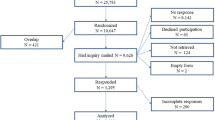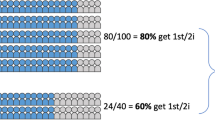Abstract
Medical student promotions committees, also known as “academic progress” or “student performance” committees, act as essential gate-keepers to the medical profession, and make decisions that have enormous impact on students’ lives and careers. However, little is currently known about how to establish fair and ethical committees that both support student development and uphold academic and professional standards. Recommendations are provided to address issues of committee structure and composition, and to provide guidance regarding information sharing, decision-making, and committee member training. The recommendations are supported by specific examples and rationale from five US medical schools in an attempt to help develop a set of best practices across institutions.
Similar content being viewed by others
References
Standards for Accreditation of Medical Education Programs Leading to the MD Degree, 2016; Standards 3.5, 9.9, 10.3. [Internet]. Liaison Committee on Medical Education [cited 2017 May 9]. Available from: http://lcme.org/publications/
Arawi T, Rosoff PM. Competing duties. J Bioeth Inq 2012;1;9(2):135–47.
Green EP, Gruppuso PA. Justice and care: decision making by medical school student promotions committees. BMC Med Educ. 2017;51:621–32.
Standards and guidance for undergraduate medical education; Requirements R2.12, R2.16, R2.18, R3.15. [Internet]. General Medical Council [cited 2017 May 18]. Available from: http://www.gmc-uk.org/education/standards.asp
Wear D, Keck-McNulty C, Jones B, Penn M, Moss P. Medical students’ experience of academic review and promotions committees. Teach Learn Med. 2004;16(3):226–32.
Maher BM, Hynes H, Sweeney C, Khashan AS, O’Rourke M, Doran K, et al. Medical school attrition—beyond the statistics. A ten year retrospective study. BMC Med Educ. 2013;13(1)
O’Neill LD, Wallstedt B, Eika B, Hartvigsen J. Factors associated with dropout in medical education: a literature review. BMC Med Educ. 2011;45(5):440–54.
Stetto JE, Gackstetter GD, Cruess DF, Hooper TI. Variables associated with attrition from Uniformed Services University of the Health Sciences Medical School. Mil Med. 2004;169(2):102–7.
Yates J. When did they leave, and why? A retrospective case study of attrition on the Nottingham undergraduate medical course. BMC Med Educ. 2012;12(1):1–7.
French W, Weis A. An ethics of care or an ethics of justice. J Bus Ethics. 2000;27(1–2):125–36.
Gump LS, Baker RC, Roll S. The moral justification scale: reliability and validity of a new measure of care and justice orientations. Adolescence. 2000;35(137):67–76.
Robert GH. Robert’s rules of order revised. 1921.
Cobb NH, Jordan C. Students with questionable values or threatening behavior: precedent and policy from discipline to dismissal. J Soc Work Educ. 1989;25(2):87–97.
Irby DM, Milam S. The legal context for evaluating and dismissing medical students and residents. Acad Med. 1989;64(11):639–43.
McAdams CR, Foster VA, Ward TJ. Remediation and dismissal policies in counselor education: lessons learned from a challenge in federal court. Couns Educ Supervis. 2007;46(3):212–29.
Nash DA, Moore RN, Andes JO. Academic dismissal for clinical reasons: implications of the Horowitz case. J Dent Educ. 1981;45(3):150–5.
Luhanga F, Yonge O, Myrick F. Failure to assign failing grades: issues with grading the unsafe student. Int J Nurs Educ Scholarsh. 2008;5(1):1–14.
Cruess RL, Cruess SR. Expectations and obligations: professionalism and medicine’s social contract with society. Perspect Biol Med. 2008;51(4):579–98.
Cruess SR, Johnston S, Cruess RL. “Profession”: a working definition for medical educators. Teach Learn Med. 2004;16(1):74–6.
Morphew CC, Hartley M. Mission statements: a thematic analysis of rhetoric across institutional type. J Higher Educ. 2006;77(3):456–71.
Tierney WG. Organizational culture in higher education: defining the essentials. J Higher Educ. 1988;59(1):2.
Mission, Vision, and Goals [Internet]. University of Central Florida College of Medicine [cited 2017 May 9]. Available from: https://med.ucf.edu/about/strategic-plan/mission-vision-and-goals/
Mission, Vision, and Values, Division of Biology and Medicine [Internet]. Brown University [cited 2017 May 9]. Available from: http://biomed.brown.edu/dean/mission.
Mission Statement, Student Affairs [Internet]. Warren Alpert Medical School of Brown University [cited 2017 May 9]. Available from: https://www.brown.edu/academics/medical/student-affairs.
Coulehan J, Williams PC. Vanquishing virtue: the impact of medical education. Acad Med. 2001;76(6):598–605.
Hafferty FW. Beyond curriculum reform: confronting medicine’s hidden curriculum. Acad Med. 1998;73(4):403–7.
Hafferty FW, Franks R. The hidden curriculum, ethics teaching, and the structure of medical education. Acad Med. 1994;69(11):861–71.
Notes on Contributors
Emily P. Green, PhD, MA is Assistant Professor of Medical Science and the Director of Student and Faculty Development at the Warren Alpert Medical School of Brown University, and an ex-officio member of the Medical Committee on Academic Standing and Professionalism.
Gary Beck Dallaghan, PhD is Assistant Dean for Medical Education at the University of Nebraska College of Medicine, and an ex-officio member of the Student Evaluation Committee.
Daniel O’Hearn, MD is an Associate Professor of Medicine at the Oregon Health & Science University, and Chair of the Medical Student Progress Board.
Marcia L. Verduin, MD is Associate Dean for Students at the University of Central Florida College of Medicine, and an ex-officio member of the Student Evaluation and Promotion Committees.
Christa H. Zehle, MD is Associate Dean for Students at the Robert Larner, MD College of Medicine at the University of Vermont, and an ex-officio member of the Committee on Advancement.
Author information
Authors and Affiliations
Corresponding author
Ethics declarations
Conflict of Interest
The authors declare that there is no conflict of interest.
Rights and permissions
About this article
Cite this article
Green, E.P., Beck Dallaghan, G.L., O’Hearn, D.J. et al. Establishing Fair and Ethical Medical Student Promotions Committees. Med.Sci.Educ. 28, 561–567 (2018). https://doi.org/10.1007/s40670-018-0582-x
Published:
Issue Date:
DOI: https://doi.org/10.1007/s40670-018-0582-x




